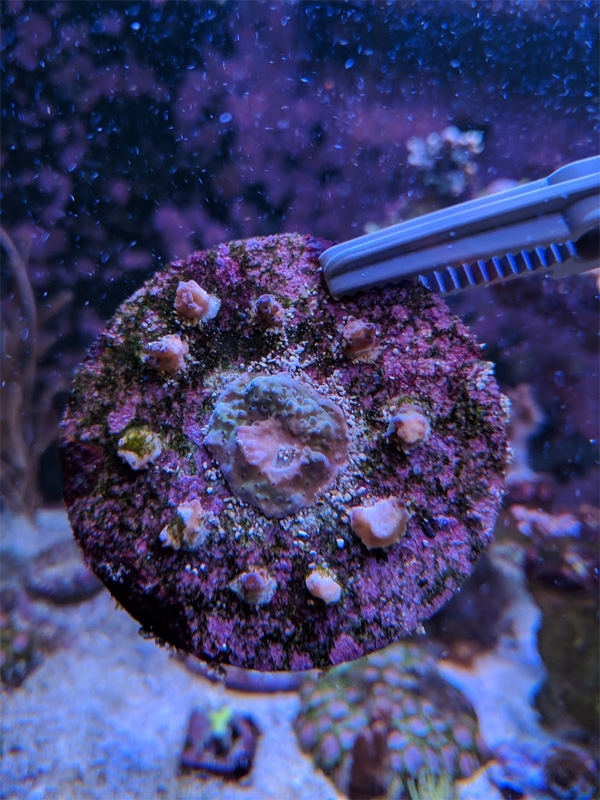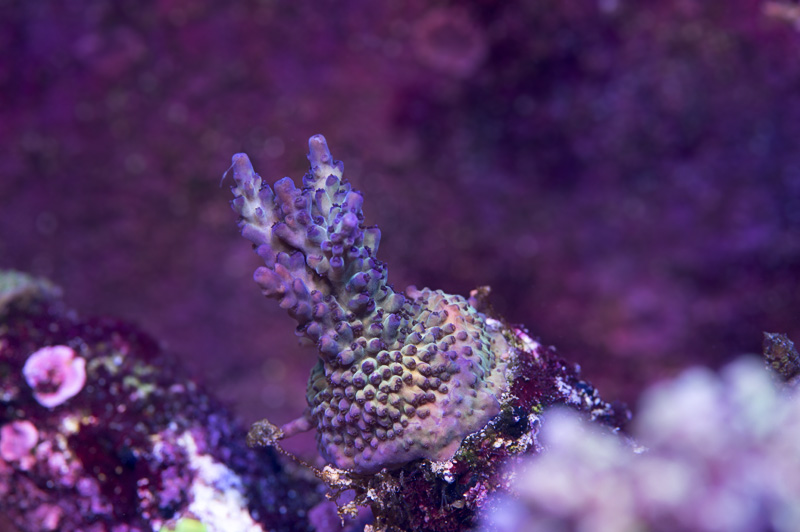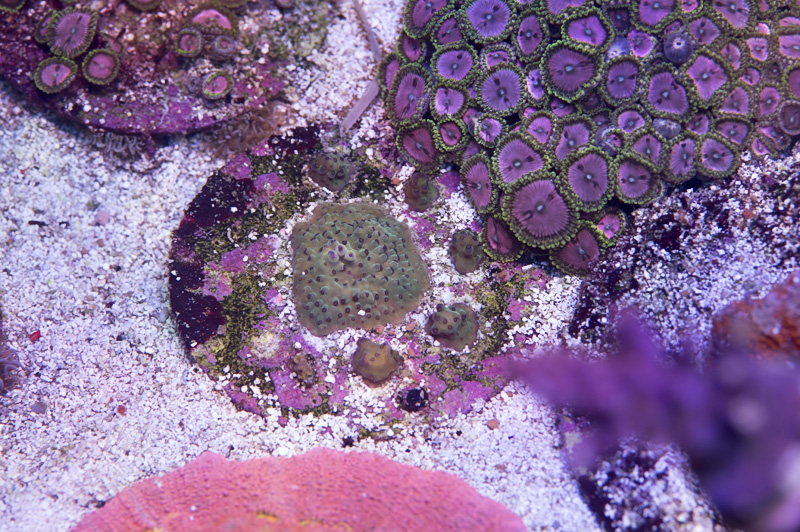You are using an out of date browser. It may not display this or other websites correctly.
You should upgrade or use an alternative browser.
You should upgrade or use an alternative browser.
Faster growing frags? Suspended frags? Micro frags?
- Thread starter Bruce Spiegelman
- Start date
so why glue all the micro frags next to each other? if they start to encrust wont they just end up hitting each other? would it be better to glue the micro frags on separate plugs, or a bigger flat plate plug thingy. so they can grow more before colliding.
Agree.
The reason why you glue the microfrags close together is so that they can encrust and then fuse together faster. Once they fuse together, then the "colony" will behave as if it was a larger piece than each of the individual pieces.
Here's what the micro frags look like as of yesterday.

Here's what the micro frags look like as of yesterday.

Attachments
how do you even get those glued so clean...
Eric has the hands of a surgeon...
Not too hard to glue it on cleanly. Just a tiny frag with some water on the end of your fingertips and then basically drop it on top of the ic gel. You could also use a set of fine tweezers if you're more comfortable with that, but I haven't had the need to for these frags or the ones for the GARF bonsai encrusting pieces.
Bruce Spiegelman
Supporting Member
jccaclimber
Supporting Member
I very done this many times to create colonies and frags faster than I could have otherwise. Here are a few methods I've used, and things to remember:
1) TANSTAAFL. Corals aren't 2d, they are 3d. When you do this with say an encrypting month you are really redirecting the growth to some place more convenient for you. For example back in DFW I have a mystic month that is a 8-9" circle. It encrusts at X inches per year at the edges, but is also getting thicker and growing little bumps and occasional shelves in the center. Think if it as constant volume, not constant linear expansion. When you make little frags the polyps can encrust outwards which increases their surface are quickly rather than forming a large lump which increases surface area slowly, but may still be producing skeleton at a similar rate.
2) TANSTAAFL Part 2. As soon as the pieces have grafted together you no longer have extra edges and are once more growing at normal pace.
3) TANSTAAFL Part 3. A large colony does grow a bit faster at the edge than a small one. I suspect this is because the land locked polyps are providing energy to the open edges. That same mystic monti encrusted several inches on the underside of a totally dark ledge and this is the only explanation I have. Note that this faster entrusting rate is still slower than the rate of you start a bunch of small frags ahead of the leading edge.
4) Practical Applications. My favorite is to glue a pea sized block of monti on a plug. Once it has encrusted I snap the original pea sized piece off and move it to another plug. The first plug now has a ring that is growing at the inside and outside edge, and fills in very quickly.
5) It may seem obvious, but remember that this will change colony shape. As an example I have a few colonies of the same purple stylo. One grew naturally, is tall, narrow, and has a really thick trunk to its tree shape. Another was started from 5+ little frags it is short, broad, and looks more like a hedge row with many trunks all interconnecting. I'm not saying one is better or worse than the other, but they are different. This can be used to your advantage if say you want a colony that curves along a ridge or other feature.
1) TANSTAAFL. Corals aren't 2d, they are 3d. When you do this with say an encrypting month you are really redirecting the growth to some place more convenient for you. For example back in DFW I have a mystic month that is a 8-9" circle. It encrusts at X inches per year at the edges, but is also getting thicker and growing little bumps and occasional shelves in the center. Think if it as constant volume, not constant linear expansion. When you make little frags the polyps can encrust outwards which increases their surface are quickly rather than forming a large lump which increases surface area slowly, but may still be producing skeleton at a similar rate.
2) TANSTAAFL Part 2. As soon as the pieces have grafted together you no longer have extra edges and are once more growing at normal pace.
3) TANSTAAFL Part 3. A large colony does grow a bit faster at the edge than a small one. I suspect this is because the land locked polyps are providing energy to the open edges. That same mystic monti encrusted several inches on the underside of a totally dark ledge and this is the only explanation I have. Note that this faster entrusting rate is still slower than the rate of you start a bunch of small frags ahead of the leading edge.
4) Practical Applications. My favorite is to glue a pea sized block of monti on a plug. Once it has encrusted I snap the original pea sized piece off and move it to another plug. The first plug now has a ring that is growing at the inside and outside edge, and fills in very quickly.
5) It may seem obvious, but remember that this will change colony shape. As an example I have a few colonies of the same purple stylo. One grew naturally, is tall, narrow, and has a really thick trunk to its tree shape. Another was started from 5+ little frags it is short, broad, and looks more like a hedge row with many trunks all interconnecting. I'm not saying one is better or worse than the other, but they are different. This can be used to your advantage if say you want a colony that curves along a ridge or other feature.
Bruce Spiegelman
Supporting Member
I very done this many times to create colonies and frags faster than I could have otherwise. Here are a few methods I've used, and things to remember:
1) TANSTAAFL. Corals aren't 2d, they are 3d. When you do this with say an encrypting month you are really redirecting the growth to some place more convenient for you. For example back in DFW I have a mystic month that is a 8-9" circle. It encrusts at X inches per year at the edges, but is also getting thicker and growing little bumps and occasional shelves in the center. Think if it as constant volume, not constant linear expansion. When you make little frags the polyps can encrust outwards which increases their surface are quickly rather than forming a large lump which increases surface area slowly, but may still be producing skeleton at a similar rate.
2) TANSTAAFL Part 2. As soon as the pieces have grafted together you no longer have extra edges and are once more growing at normal pace.
3) TANSTAAFL Part 3. A large colony does grow a bit faster at the edge than a small one. I suspect this is because the land locked polyps are providing energy to the open edges. That same mystic monti encrusted several inches on the underside of a totally dark ledge and this is the only explanation I have. Note that this faster entrusting rate is still slower than the rate of you start a bunch of small frags ahead of the leading edge.
4) Practical Applications. My favorite is to glue a pea sized block of monti on a plug. Once it has encrusted I snap the original pea sized piece off and move it to another plug. The first plug now has a ring that is growing at the inside and outside edge, and fills in very quickly.
5) It may seem obvious, but remember that this will change colony shape. As an example I have a few colonies of the same purple stylo. One grew naturally, is tall, narrow, and has a really thick trunk to its tree shape. Another was started from 5+ little frags it is short, broad, and looks more like a hedge row with many trunks all interconnecting. I'm not saying one is better or worse than the other, but they are different. This can be used to your advantage if say you want a colony that curves along a ridge or other feature.
It's like coral bonsai.
@jccaclimber, what does TANSTAAFL stand for?
jccaclimber
Supporting Member
There Ain't No Such Thing As A Free Lunch.
Sorry for the late update, but been changing things on the tank.
Here's the piece on the rockwork, now getting hit with 550 PAR (and climbing).

The disk that's on the sandbed, now getting 250 PAR (climbing as well).

A few of the nubs on the disk is missing. They were knocked off awhile back and I forgot to pick them back up and reglue them. Overall, the micro frags are doing well and are starting to encrust as well as growing vertically. Once they touch each other, I would expect the growth to increase as well.
Here's the piece on the rockwork, now getting hit with 550 PAR (and climbing).

The disk that's on the sandbed, now getting 250 PAR (climbing as well).

A few of the nubs on the disk is missing. They were knocked off awhile back and I forgot to pick them back up and reglue them. Overall, the micro frags are doing well and are starting to encrust as well as growing vertically. Once they touch each other, I would expect the growth to increase as well.
Bruce Spiegelman
Supporting Member
That's pretty impressive growth for three months.


